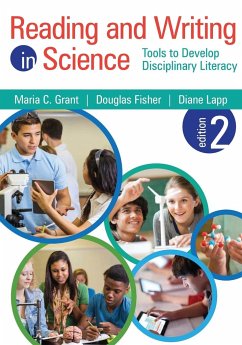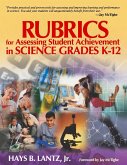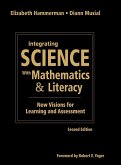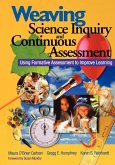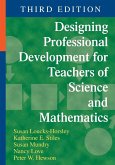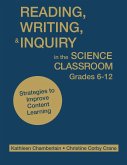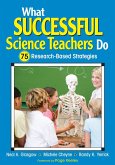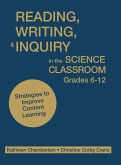Maria C. Grant, Douglas Fisher, Diane Lapp
Reading and Writing in Science
Tools to Develop Disciplinary Literacy
Maria C. Grant, Douglas Fisher, Diane Lapp
Reading and Writing in Science
Tools to Develop Disciplinary Literacy
- Broschiertes Buch
- Merkliste
- Auf die Merkliste
- Bewerten Bewerten
- Teilen
- Produkt teilen
- Produkterinnerung
- Produkterinnerung
Engage your students in scientific thinking across disciplines! Did you know that scientists spend more than hal
Andere Kunden interessierten sich auch für
![Rubrics for Assessing Student Achievement in Science Grades K-12 Rubrics for Assessing Student Achievement in Science Grades K-12]() Hays B. Lantz Jr.Rubrics for Assessing Student Achievement in Science Grades K-1245,99 €
Hays B. Lantz Jr.Rubrics for Assessing Student Achievement in Science Grades K-1245,99 €![Integrating Science with Mathematics & Literacy Integrating Science with Mathematics & Literacy]() Elizabeth HammermanIntegrating Science with Mathematics & Literacy90,99 €
Elizabeth HammermanIntegrating Science with Mathematics & Literacy90,99 €![Weaving Science Inquiry and Continuous Assessment Weaving Science Inquiry and Continuous Assessment]() Maura O'Brien CarlsonWeaving Science Inquiry and Continuous Assessment34,99 €
Maura O'Brien CarlsonWeaving Science Inquiry and Continuous Assessment34,99 €![Designing Professional Development for Teachers of Science and Mathematics Designing Professional Development for Teachers of Science and Mathematics]() Katherine E StilesDesigning Professional Development for Teachers of Science and Mathematics49,99 €
Katherine E StilesDesigning Professional Development for Teachers of Science and Mathematics49,99 €![Reading, Writing, and Inquiry in the Science Classroom, Grades 6-12 Reading, Writing, and Inquiry in the Science Classroom, Grades 6-12]() Kathleen ChamberlainReading, Writing, and Inquiry in the Science Classroom, Grades 6-1236,99 €
Kathleen ChamberlainReading, Writing, and Inquiry in the Science Classroom, Grades 6-1236,99 €![What Successful Science Teachers Do What Successful Science Teachers Do]() Neal A. GlasgowWhat Successful Science Teachers Do43,99 €
Neal A. GlasgowWhat Successful Science Teachers Do43,99 €![Reading, Writing, and Inquiry in the Science Classroom, Grades 6-12 Reading, Writing, and Inquiry in the Science Classroom, Grades 6-12]() Kathleen ChamberlainReading, Writing, and Inquiry in the Science Classroom, Grades 6-1281,99 €
Kathleen ChamberlainReading, Writing, and Inquiry in the Science Classroom, Grades 6-1281,99 €-
-
-
Engage your students in scientific thinking across disciplines! Did you know that scientists spend more than hal
Hinweis: Dieser Artikel kann nur an eine deutsche Lieferadresse ausgeliefert werden.
Hinweis: Dieser Artikel kann nur an eine deutsche Lieferadresse ausgeliefert werden.
Produktdetails
- Produktdetails
- Verlag: Corwin
- 2. Auflage
- Seitenzahl: 192
- Erscheinungstermin: 27. Januar 2015
- Englisch
- Abmessung: 254mm x 178mm x 11mm
- Gewicht: 373g
- ISBN-13: 9781483345680
- ISBN-10: 1483345688
- Artikelnr.: 41416461
- Herstellerkennzeichnung
- Libri GmbH
- Europaallee 1
- 36244 Bad Hersfeld
- gpsr@libri.de
- Verlag: Corwin
- 2. Auflage
- Seitenzahl: 192
- Erscheinungstermin: 27. Januar 2015
- Englisch
- Abmessung: 254mm x 178mm x 11mm
- Gewicht: 373g
- ISBN-13: 9781483345680
- ISBN-10: 1483345688
- Artikelnr.: 41416461
- Herstellerkennzeichnung
- Libri GmbH
- Europaallee 1
- 36244 Bad Hersfeld
- gpsr@libri.de
Maria C. Grant, EdD, is a professor in the Department of Secondary Education at California State University Fullerton and the director of the Single Subject Credential Program at CSUF. She works with both pre-service and in-service teachers in the credential program and at school sites. Her work includes research and publications in the areas of disciplinary literacy, literacy in the content areas, science education, and pedagogy. In addition to her efforts at the university, Maria's experience includes many years of teaching in high school and middle school science classrooms. She has taught physics, oceanography, coordinated science, chemistry, and earth science. She currently supports learners as teacher and coach at Health Sciences High & Middle College. Over the years, Maria has acted as a leader in curriculum development and professional development at both the school and district levels. Her most recent efforts include research and professional development work centered on reading, writing, and language within content classrooms. Maria can be reached at mgrant@fullerton.edu. Follow her on twitter at @mgrantfullerton
Introduction
New to This Edition
About the Authors
1. Teaching Students to Think Like Scientists
How Well Are U.S. Students Doing in Science?
What Foundations Do We Need to Have in Place?
What Are the Features of Purposeful Science Instruction?
What Do Real-World Scientists Do?
2. Knowing and Using Scientific Language to Communicate Like a Scientist
Language Is the Foundation for Learning
Using Language in Science
Connecting the Common Core State Standards and the Next Generation Science
Standards
Next Generation Science Standards Support the Precision of Language Use
Science Instruction
Assess to Instruct: Developing Knowledge and Language
Fostering Independent Word Learning in Science
Word Play Promotes Increased Vocabulary Knowledge
3. Reading Like a Scientist
Connecting the Next Generation Science Standards and the Common Core State
Standards
Features That Make Texts Complex
Teaching Students to Read Science Texts
Collaborative Conversations Support Learning and Sharing Scientific
Language and Concepts
The Connection Between Vocabulary and Reading Success
Why Teach Reading in Science?
4. Writing Like a Scientist
Connecting the Common Core State Writing Standards and the Next Generation
Science Standards
Writing Like a Scientist Is Different
WebQuest: Collecting Data for Writing
Writing Frames: Scaffolds for Scientific Writing
Teaching Scientific Phrasing
Writing Formats in Science
Writing Well-Supported Arguments
Why Learn to Write Like a Scientist?
5. Assessing Student Learning in Science
The Purpose of Assessment in Science
Using Assessment Information
Identifying Literacy-Language Strengths and Needs
Creating Science Assessments
Final Thoughts About Assessment
References
Index
New to This Edition
About the Authors
1. Teaching Students to Think Like Scientists
How Well Are U.S. Students Doing in Science?
What Foundations Do We Need to Have in Place?
What Are the Features of Purposeful Science Instruction?
What Do Real-World Scientists Do?
2. Knowing and Using Scientific Language to Communicate Like a Scientist
Language Is the Foundation for Learning
Using Language in Science
Connecting the Common Core State Standards and the Next Generation Science
Standards
Next Generation Science Standards Support the Precision of Language Use
Science Instruction
Assess to Instruct: Developing Knowledge and Language
Fostering Independent Word Learning in Science
Word Play Promotes Increased Vocabulary Knowledge
3. Reading Like a Scientist
Connecting the Next Generation Science Standards and the Common Core State
Standards
Features That Make Texts Complex
Teaching Students to Read Science Texts
Collaborative Conversations Support Learning and Sharing Scientific
Language and Concepts
The Connection Between Vocabulary and Reading Success
Why Teach Reading in Science?
4. Writing Like a Scientist
Connecting the Common Core State Writing Standards and the Next Generation
Science Standards
Writing Like a Scientist Is Different
WebQuest: Collecting Data for Writing
Writing Frames: Scaffolds for Scientific Writing
Teaching Scientific Phrasing
Writing Formats in Science
Writing Well-Supported Arguments
Why Learn to Write Like a Scientist?
5. Assessing Student Learning in Science
The Purpose of Assessment in Science
Using Assessment Information
Identifying Literacy-Language Strengths and Needs
Creating Science Assessments
Final Thoughts About Assessment
References
Index
Introduction
New to This Edition
About the Authors
1. Teaching Students to Think Like Scientists
How Well Are U.S. Students Doing in Science?
What Foundations Do We Need to Have in Place?
What Are the Features of Purposeful Science Instruction?
What Do Real-World Scientists Do?
2. Knowing and Using Scientific Language to Communicate Like a Scientist
Language Is the Foundation for Learning
Using Language in Science
Connecting the Common Core State Standards and the Next Generation Science
Standards
Next Generation Science Standards Support the Precision of Language Use
Science Instruction
Assess to Instruct: Developing Knowledge and Language
Fostering Independent Word Learning in Science
Word Play Promotes Increased Vocabulary Knowledge
3. Reading Like a Scientist
Connecting the Next Generation Science Standards and the Common Core State
Standards
Features That Make Texts Complex
Teaching Students to Read Science Texts
Collaborative Conversations Support Learning and Sharing Scientific
Language and Concepts
The Connection Between Vocabulary and Reading Success
Why Teach Reading in Science?
4. Writing Like a Scientist
Connecting the Common Core State Writing Standards and the Next Generation
Science Standards
Writing Like a Scientist Is Different
WebQuest: Collecting Data for Writing
Writing Frames: Scaffolds for Scientific Writing
Teaching Scientific Phrasing
Writing Formats in Science
Writing Well-Supported Arguments
Why Learn to Write Like a Scientist?
5. Assessing Student Learning in Science
The Purpose of Assessment in Science
Using Assessment Information
Identifying Literacy-Language Strengths and Needs
Creating Science Assessments
Final Thoughts About Assessment
References
Index
New to This Edition
About the Authors
1. Teaching Students to Think Like Scientists
How Well Are U.S. Students Doing in Science?
What Foundations Do We Need to Have in Place?
What Are the Features of Purposeful Science Instruction?
What Do Real-World Scientists Do?
2. Knowing and Using Scientific Language to Communicate Like a Scientist
Language Is the Foundation for Learning
Using Language in Science
Connecting the Common Core State Standards and the Next Generation Science
Standards
Next Generation Science Standards Support the Precision of Language Use
Science Instruction
Assess to Instruct: Developing Knowledge and Language
Fostering Independent Word Learning in Science
Word Play Promotes Increased Vocabulary Knowledge
3. Reading Like a Scientist
Connecting the Next Generation Science Standards and the Common Core State
Standards
Features That Make Texts Complex
Teaching Students to Read Science Texts
Collaborative Conversations Support Learning and Sharing Scientific
Language and Concepts
The Connection Between Vocabulary and Reading Success
Why Teach Reading in Science?
4. Writing Like a Scientist
Connecting the Common Core State Writing Standards and the Next Generation
Science Standards
Writing Like a Scientist Is Different
WebQuest: Collecting Data for Writing
Writing Frames: Scaffolds for Scientific Writing
Teaching Scientific Phrasing
Writing Formats in Science
Writing Well-Supported Arguments
Why Learn to Write Like a Scientist?
5. Assessing Student Learning in Science
The Purpose of Assessment in Science
Using Assessment Information
Identifying Literacy-Language Strengths and Needs
Creating Science Assessments
Final Thoughts About Assessment
References
Index

